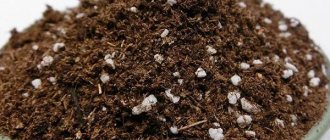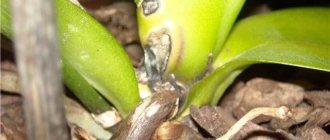If the color of the orchid roots has turned white, green or brown: why is this happening and what to do?
The root system of an orchid is significantly different from other indoor plants.
After all, part of the roots is underground, and the rest is on top of the soil in the pot. Accordingly, many questions arise about this.
It is important to understand what they look like in their natural state and how to recognize a diseased root.
How to distinguish living roots from dead ones?
If the appearance of the orchid has become depressing and causes concern, carefully examine it. Please note the following:
- condition of leaves . If the roots of the orchid begin to rot, the leaves will quickly turn yellow, become covered with brown spots and die off one by one;
- flowering duration . A plant with a damaged root system is simply not able to feed the buds. Eventually they crumble;
- bush stability . If the orchid falls on its side, or sways a lot when lifting the pot, it means it has nothing to hold on to the substrate. Its roots have weakened.
If at least one of the listed signs is detected, it is necessary to free the flower from the soil, determining the condition of the roots. Live roots are distinguished from dead ones as follows:
- by color - healthy ones range in color from whitish to green, rotten ones are black or brown in color;
- to the touch - living ones have an elastic, dense texture, dead ones have a hollow texture, when pressed they crumple, moisture flows out of them, the outer layer is removed down to the inner vein (similar to a thread).
What should the normal color of a healthy root system be?
The root is a vegetative organ that is responsible for vital processes. With the help of roots, the epiphytic orchid is attached to the substrate, thereby maintaining a vertical position.
A change in shades of underground or aerial roots is a signal that you need to pay attention to the flower. The normal color of healthy roots is light green or pale gray . When moistened with water, the color acquires a rich, dark shade. Not a normal color - dark brown, pale yellow with a white coating (learn more about white plaque and its treatment in this material).
In normal condition, the color of the velamen is bright white. Therefore, it is assumed that the color scheme of the root system can range from green to silver.
However,
the color of orchid roots may differ depending on :
- varieties;
- the substrate in which they grow;
- use of mineral fertilizers;
- lighting.
It should be noted that determining the condition of the roots solely by color is wrong. It is important to examine their physical condition. Healthy roots are elastic, smooth, dense . If, when pressed, a fingerprint remains on the root sprout, it means it is rotten or rotten.
By the color of the root system you can determine what disease the plant is susceptible to.
We offer you to watch a visual video about the color of the roots:
Read about what the color of orchid roots means here.
Orchid diseases
It is important to know the signs of various diseases in an orchid in order to fight them without bringing the plant to a state of death. So that we don’t have to do emergency resuscitation later, let’s see how to save an orchid from disease.
Rust
Signs: orange spots on the inside of the flower, growth slows down or stops altogether. The printed publications write that, unfortunately, such an orchid must be destroyed, otherwise the disease will quickly spread to other indoor plants.
Fusarium
Signs: shoots and leaves rot, the flower withers. The reason is that the room is too humid and poorly ventilated. No spraying during treatment! Ventilate the room often to remove rot.
Brown rot
Signs: brown spots on the flower, it withers and turns yellow. Urgently cut out these spots, treat the cut areas thoroughly with ash or ash. Treat the orchid with special preparations that contain copper.
Anthracnose
Signs: the orchid appears brown spots with black spots. You also remove stained areas and treat them with ash or ash. Do not feed the orchid during treatment.
Step-by-step instructions: what to do if the color has changed?
To green
The outer shell of the root, velamen, turns green when moistened, and when it dries it takes on a silver-gray tint. The green color of the root system indicates the health of the orchid . It is easy to determine the stage of growth by the color of the roots - young roots have a light green color, while the old root system has a more faded, inexpressive shade.
To white
This color change is associated with the use of tap, untreated water for irrigation. Hard water contains a large percentage of salts , which tend to accumulate in the soil, thereby changing its composition and blocking the flow of air to the roots. As a result, you can see a white coating on the surface of the substrate and rhizome.
carefully remove the flower from the pot and remove the remaining soil;- rinse the roots under running warm water;
- trim damaged areas of roots;
- transplant into an orchid in a new substrate;
- use exclusively purified, soft water for irrigation;
- update the soil every three years, at least.
Experienced gardeners advise collecting melt or rainwater and using it to moisten the plant.
To brown
It is important to regularly inspect the root system of epiphytes . If the flower is planted in a transparent pot, this is easy to do. It is more difficult if the orchid grows in a ceramic or clay pot, with limited access to light. In this case, the color of the roots may change.
Let's look at what's wrong if the roots of your home orchid turn brown. A similar color on the root shoots may appear due to deep planting in the substrate. Roots, with a lack of natural light, cannot fully participate in the process of photosynthesis, and as a result, chlorophyll, which is responsible for the green color, is not produced.
- take the flower out of the old pot;
- immerse the lower part of the plant in a container with warm water, leave for 2 hours;
- carefully wipe the roots with a paper towel;
- if there are damaged areas, remove them;
- transplants the orchid into a plastic transparent pot;
- place it in a well-lit place.
What to do if the shade changes?
The most common causes of rhizome malaise are:
lack of life-giving moisture;- bad light;
- poor soil quality;
- inappropriate pot size;
- mechanical damage to roots;
- temperature and humidity conditions do not meet the norm;
- use of hard water;
- damage by infections;
- natural aging process.
Green
Green color indicates the health of the plant. The root system performs its direct functions: holding the plant in the substrate, feeding it with moisture and microelements, and also participates in the vital processes of gas exchange and photosynthesis. The light green color also indicates the appearance of new, young roots.
White
Similar troubles happen when using unfiltered, hard water for irrigation. In this case, a significant amount of salts accumulate in the soil, which change its composition and prevent the penetration of air. This is why there is a white coating on the soil and rhizome.
Measures taken:
- Rinse the flower in the pot under running water.
- Remove damaged parts of roots, if any.
- Change substrate.
- Moisten only with soft water.
Read more about why white plaque appears on orchid leaves and how to deal with it with home remedies.
Brown
What could be the matter if the rhizome turns brown? Orchids require regular inspection. If the flower is planted in a transparent container, this is easy to do. When the color of the roots changes, you should pay attention to the conditions under which the plant is kept.
A brown color may appear if the roots are planted deep enough in the soil.
- We remove the orchid from the flowerpot.
- Rinse the roots with warm running water.
- Let them dry.
- We cut off damaged areas, if any.
- Transplant the flower into a transparent pot.
- We place it in a well-lit place.
- As a result of an excess of liquid in the flowerpot, rot diseases develop. Among which: root, gray, brown rot. Symptoms of the disease are precisely the brown color of the roots, brown spots on the leaves and buds.
- Creating optimally comfortable conditions for the orchid.
- Move the diseased plant away from healthy flowers.
- Remove damaged areas.
- Treat the soil and plant with a 0.2% solution of Fundazol or Topsina; in this case, an effective method is to immerse the pot in a chemical mixture.
- Carry out the procedure at least three times with an interval of 2 weeks.
The leaves dried up, but the roots remained green
If the orchid has withered, but the rhizome remains green, then what could be the reason and what should be done in such cases?
What to do if the plant has withered, but the root system is still green?
There can be a large number of factors when the leaves have dried out and the roots are still green, ranging from banal hypothermia to serious fungal diseases. Read about what to do if mold appears in a pot with an orchid here.
- Cold air entering the plant.
Of course, hypothermia provokes the shedding of buds and loss of turgor by the leaves, but the root system will remain intact. Unfortunately, affected flowers and leaves cannot be treated. Lifeless foliage must be removed, and then the pot with the plant must be moved to a warmer room and watered. In the future, avoid drafts. With proper care, after a while, young shoots will appear. Excess moisture .
Excessive moisture causes rot. A damaged orchid gradually loses its foliage, but the roots may remain partially healthy. The leaves become soft and flabby. In such a situation, you should:
- remove the orchid from the pot;
- clean the root system of soil residues and rinse with warm water;
- remove sore spots, treat sections with crushed activated carbon;
- leave the flower to dry overnight;
- transplant the exotic into a new substrate, with the obligatory presence of a drainage layer;
- control the irrigation system.
With fusarium wilt , the fungal infection spreads quite quickly, damaging the leaves.
They begin to turn yellow and fall off. If the stage of damage is not advanced, then the root system may still be healthy. Therefore, it is important to take urgent measures:- quarantine the flower;
create favorable conditions for growth;
- treat the remaining upper part of the orchid and the surface of the soil with a fungicide solution.
If the cause of the disease cannot be determined, it is better to transfer the plant with healthy roots to a greenhouse. Maintain a temperature there of +25ºС, humidity 60-70%. Be sure to provide intense lighting and regular watering with soft water. Regrowth of foliage is not a quick process, so you should be patient .
To forget about problems with roots, you should follow three recommendations: maintain the correct watering schedule, maintain a comfortable temperature and humidity, and provide the plant with a bright place. The rules are simple, but if you follow them, they will bring a lot of benefits.
Various diseases of orchid roots and their treatment
Orchids get sick because basic care rules are not followed:
Next, we will look in detail at what orchids suffer from and how to treat them.
White plaque
The roots of the plant may acquire a white coating if hard water with various salt impurities was used during irrigation. They gradually settle on the bicycle and tightly block the access of oxygen.
Actions on
how to cure a root covered with such plaque:
- remove the plant from the bark and rinse them well;
- if there are bad roots, cut them off with pruning shears;
- change the bark.
Subsequent watering should be done with soft filtered water and do not overdo it with fertilizing.
Read more about why orchid roots turn white here.
Yellowed
The yellowness varies - if the roots are elastic and without damage with a growing end, then it is obvious that they grew inside the bark and did not have enough light . But if, with a yellow tint, they are empty and easily lose their velomen, then they are already dead, having dried out without moisture or after damage.
We don’t touch the healthy ones, but what has dried out is cut off when transplanting the plant into a new container.
Read more about the causes of yellowing roots in this article.
Blackened
Blackness on the root system is a fairly common phenomenon. If you press on such a root and you hear a crunch, then it is clear that it is dead.
- too old orchid;
- fungal or bacterial disease;
- waterlogging and, as a result, rot;
- poor lighting due to scattered sunlight.
To help the plant, it needs to create the necessary conditions for good growth.
You can find more information on how to help an orchid with blackening roots here.
Became brown
The brown tint appears where they are deep under the bark layer.
The lack of light gives them a brown tint, but they are absolutely healthy. There is no green tint because there is no photosynthesis process.
To ensure that the roots are of a normal shade, the flower is transplanted into a container with transparent walls.
Read more about why roots turn brown in this article.
Green roots - is this normal?
Green roots are a natural process . At the moment when the plant is saturated with moisture, immediately after watering they have a bright green color. Some time later they will turn light gray, this will indicate that the flower needs regular watering.
Mold
Mold appears when there is constant high humidity and high temperatures . This will be an ideal breeding ground for mold. To prevent it from appearing, you must follow the correct watering regime , allowing the roots to be saturated with oxygen, which enters through the layers of bark.
If mold has already appeared on the roots, what should you do? The plant is removed from the soil and washed in a weak solution of potassium manganese . This will help remove mold. If severely damaged roots are noticed, they will have to be removed.
Causes of root rotting
The roots of an orchid rot if they are not maintained correctly or if they are affected by diseases. In most cases, the plant can be saved if the cause of the disease is correctly determined.
Too much watering . When the substrate is constantly wet, the roots cannot drink. Paradoxical as it may seem, this is exactly so. The soil should dry out between waterings. That is, the sun's rays should penetrate it, drying it. Light is the main condition under which roots can drink water. If there is little of it, then when the soil is wet, water does not flow to the leaves.
Dense soil . Fresh substrate is distinguished by the presence of individual elements that do not fit tightly into the pot. An air gap remains between the soil particles. Oxygen enters the roots, allowing them to breathe. Over time, the bark of trees, which is part of the soil, is destroyed. It becomes smaller and denser. The air gap disappears. As a result, the roots of the orchid rot due to suffocation.
The roots of the orchid are rotting, what should I do? Photo
Excessive fertilization . The delicate structure of the roots is very sensitive to the concentration of fertilizers and the frequency of their application. A large dose can cause chemical burns and death of living tissue.
Man-made damage. If, when transplanting a flower, several roots break off and you do not treat them, expect trouble. Living tissue is a passage for bacteria and infections. It is not able to supply water to the leaves, but, being in a humid environment, it rots.
Lack of light is one of the main causes of all plant diseases. Having a special two-layer root structure, the orchid absorbs water under conditions of good lighting. Light should fall not only on the leaves and buds, the roots also need it. Without light, they are saturated with moisture, but do not supply it to the top. If there is no light for a long time, the water stagnates and destroys the root system.
Pests. A waterlogged substrate is an ideal place for breeding podurs. These are small insects that are constantly on the move. They are no larger than the tip of a needle and are white in color. They feed on decaying plant tissue. The appearance of durs is a sure sign of rotting.
Fungal diseases. If the roots of an orchid rot and characteristic yellow spots with a rotten center appear on the leaves, then soil fungi may be the cause of the disease. They develop only in unsuitable flower conditions: when there is a lot of moisture and not enough light. The roots become saturated with water and cannot push it up without good lighting.











